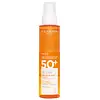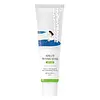What's inside
What's inside
 Key Ingredients
Key Ingredients

 Benefits
Benefits

 Concerns
Concerns

No concerns
 Ingredients Side-by-side
Ingredients Side-by-side

Water
Skin ConditioningDibutyl Adipate
EmollientDicaprylyl Carbonate
EmollientDiethylamino Hydroxybenzoyl Hexyl Benzoate
UV FilterHomosalate
Skin ConditioningOctocrylene
UV AbsorberAlcohol
AntimicrobialButyloctyl Salicylate
Skin ConditioningEthylhexyl Salicylate
UV AbsorberEthylhexyl Triazone
UV AbsorberGlycerin
HumectantBis-Ethylhexyloxyphenol Methoxyphenyl Triazine
Skin ConditioningPhenylbenzimidazole Sulfonic Acid
UV AbsorberTromethamine
BufferingPolyester-7
Skin ConditioningParfum
MaskingPolysilicone-15
UV FilterNeopentyl Glycol Diheptanoate
EmollientCalophyllum Inophyllum Seed Oil
AntimicrobialSodium Chloride
MaskingTocopheryl Acetate
AntioxidantPentylene Glycol
Skin ConditioningEthylene Brassylate
MaskingTamarindus Indica Seed Gum
Emulsion StabilisingDisodium EDTA
Citric Acid
BufferingAloe Barbadensis Leaf Juice
Skin ConditioningButylene Glycol
HumectantCapsicum Annuum Fruit Extract
AntimicrobialCassia Alata Leaf Extract
AstringentPhenoxyethanol
PreservativePlatanus Occidentalis Bark Extract
Skin ProtectingHelianthus Annuus Seed Oil
EmollientTocopherol
AntioxidantPotassium Sorbate
PreservativeRosmarinus Officinalis Leaf Extract
AntimicrobialSodium Benzoate
MaskingWater, Dibutyl Adipate, Dicaprylyl Carbonate, Diethylamino Hydroxybenzoyl Hexyl Benzoate, Homosalate, Octocrylene, Alcohol, Butyloctyl Salicylate, Ethylhexyl Salicylate, Ethylhexyl Triazone, Glycerin, Bis-Ethylhexyloxyphenol Methoxyphenyl Triazine, Phenylbenzimidazole Sulfonic Acid, Tromethamine, Polyester-7, Parfum, Polysilicone-15, Neopentyl Glycol Diheptanoate, Calophyllum Inophyllum Seed Oil, Sodium Chloride, Tocopheryl Acetate, Pentylene Glycol, Ethylene Brassylate, Tamarindus Indica Seed Gum, Disodium EDTA, Citric Acid, Aloe Barbadensis Leaf Juice, Butylene Glycol, Capsicum Annuum Fruit Extract, Cassia Alata Leaf Extract, Phenoxyethanol, Platanus Occidentalis Bark Extract, Helianthus Annuus Seed Oil, Tocopherol, Potassium Sorbate, Rosmarinus Officinalis Leaf Extract, Sodium Benzoate
Water
Skin ConditioningZinc Oxide
Cosmetic ColorantCyclohexasiloxane
EmollientButyloctyl Salicylate
Skin ConditioningPropanediol
SolventPropylheptyl Caprylate
EmollientIsododecane
EmollientCaprylyl Methicone
Skin ConditioningLauryl Polyglyceryl-3 Polydimethylsiloxyethyl Dimethicone
Skin ConditioningMethyl Methacrylate Crosspolymer
Methyl Trimethicone
Skin ConditioningAdansonia Digitata Seed Extract
Skin ConditioningCryptomeria Japonica Leaf Extract
HumectantNelumbo Nucifera Leaf Extract
Skin ConditioningSaccharomyces Ferment Filtrate
HumectantGlyceryl Glucoside
HumectantSodium Hyaluronate
HumectantHyaluronic Acid
HumectantGlycerin
HumectantButylene Glycol
HumectantTriethoxycaprylylsilane
Artemisia Annua Extract
MaskingAnthemis Nobilis Flower Oil
MaskingPinus Sylvestris Leaf Oil
MaskingEthylhexylglycerin
Skin ConditioningAscorbic Acid
AntioxidantTocopherol
AntioxidantGlyceryl Caprylate
EmollientCaprylyl Glycol
EmollientPolymethylsilsesquioxane
1,2-Hexanediol
Skin ConditioningPolyglyceryl-2 Dipolyhydroxystearate
Skin ConditioningDisteardimonium Hectorite
StabilisingMagnesium Sulfate
Water, Zinc Oxide, Cyclohexasiloxane, Butyloctyl Salicylate, Propanediol, Propylheptyl Caprylate, Isododecane, Caprylyl Methicone, Lauryl Polyglyceryl-3 Polydimethylsiloxyethyl Dimethicone, Methyl Methacrylate Crosspolymer, Methyl Trimethicone, Adansonia Digitata Seed Extract, Cryptomeria Japonica Leaf Extract, Nelumbo Nucifera Leaf Extract, Saccharomyces Ferment Filtrate, Glyceryl Glucoside, Sodium Hyaluronate, Hyaluronic Acid, Glycerin, Butylene Glycol, Triethoxycaprylylsilane, Artemisia Annua Extract, Anthemis Nobilis Flower Oil, Pinus Sylvestris Leaf Oil, Ethylhexylglycerin, Ascorbic Acid, Tocopherol, Glyceryl Caprylate, Caprylyl Glycol, Polymethylsilsesquioxane, 1,2-Hexanediol, Polyglyceryl-2 Dipolyhydroxystearate, Disteardimonium Hectorite, Magnesium Sulfate
 Reviews
Reviews

Ingredients Explained
These ingredients are found in both products.
Ingredients higher up in an ingredient list are typically present in a larger amount.
Butylene Glycol (or BG) is used within cosmetic products for a few different reasons:
Overall, Butylene Glycol is a safe and well-rounded ingredient that works well with other ingredients.
Though this ingredient works well with most skin types, some people with sensitive skin may experience a reaction such as allergic rashes, closed comedones, or itchiness.
Learn more about Butylene GlycolButyloctyl Salicylate is a chemical UV filter structurally similar to octisalate. It is a photostabilizer, SPF booster, emollient and solvent. This ingredient helps evenly spread out ingredients.
According to a manufacturer, it is suitable for pairing with micro Titanium Dioxide, Zinc Oxide, and pigments.
Photostabilizers help stabilize UV-filters and prevents them from degrading quickly.
Learn more about Butyloctyl SalicylateGlycerin is already naturally found in your skin. It helps moisturize and protect your skin.
A study from 2016 found glycerin to be more effective as a humectant than AHAs and hyaluronic acid.
As a humectant, it helps the skin stay hydrated by pulling moisture to your skin. The low molecular weight of glycerin allows it to pull moisture into the deeper layers of your skin.
Hydrated skin improves your skin barrier; Your skin barrier helps protect against irritants and bacteria.
Glycerin has also been found to have antimicrobial and antiviral properties. Due to these properties, glycerin is often used in wound and burn treatments.
In cosmetics, glycerin is usually derived from plants such as soybean or palm. However, it can also be sourced from animals, such as tallow or animal fat.
This ingredient is organic, colorless, odorless, and non-toxic.
Glycerin is the name for this ingredient in American English. British English uses Glycerol/Glycerine.
Learn more about GlycerinTocopherol (also known as Vitamin E) is a common antioxidant used to help protect the skin from free-radicals and strengthen the skin barrier. It's also fat soluble - this means our skin is great at absorbing it.
Vitamin E also helps keep your natural skin lipids healthy. Your lipid skin barrier naturally consists of lipids, ceramides, and fatty acids. Vitamin E offers extra protection for your skin’s lipid barrier, keeping your skin healthy and nourished.
Another benefit is a bit of UV protection. Vitamin E helps reduce the damage caused by UVB rays. (It should not replace your sunscreen). Combining it with Vitamin C can decrease sunburned cells and hyperpigmentation after UV exposure.
You might have noticed Vitamin E + C often paired together. This is because it is great at stabilizing Vitamin C. Using the two together helps increase the effectiveness of both ingredients.
There are often claims that Vitamin E can reduce/prevent scarring, but these claims haven't been confirmed by scientific research.
Learn more about TocopherolWater. It's the most common cosmetic ingredient of all. You'll usually see it at the top of ingredient lists, meaning that it makes up the largest part of the product.
So why is it so popular? Water most often acts as a solvent - this means that it helps dissolve other ingredients into the formulation.
You'll also recognize water as that liquid we all need to stay alive. If you see this, drink a glass of water. Stay hydrated!
Learn more about Water